The Spotted Owl (Strix occidentalis) stands as an emblem of North American old-growth forests, captivating enthusiasts with its elusive nature and distinctive appearance.
This medium-sized owl, belonging to the Strix genus, comprises three subspecies, the Northern Spotted Owl (S. o. caurina), the Mexican Spotted Owl (S. o. lucida), and the California Spotted Owl (S. o. occidentalis).
Adorned with dark brown plumage marked by striking white spots, the Spotted Owl navigates nocturnal landscapes with stealth and precision, utilizing its acute hearing and silent flight for successful hunting.
Inhabiting diverse ecosystems, from the Pacific Northwest to the mountains of Mexico, this species faces ongoing conservation challenges due to habitat loss.
As a sentinel of forest health, the Spotted Owl plays a crucial role in ecological balance, underscoring the significance of efforts to preserve its habitats and ensure the continuity of this iconic species in North American landscapes. Stay focused.

How to Identify Spotted Owl?
The Spotted Owl (Strix occidentalis) is a charismatic and elusive bird species native to North America.
Recognizing this owl can be challenging due to its cryptic coloration and nocturnal habits, but there are key features that can aid in its identification. Here are eight points to help you identify the Spotted Owl:
Size and Shape
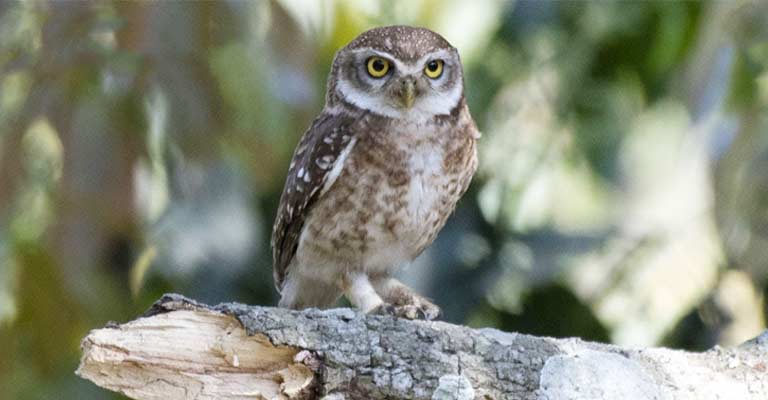
Spotted Owls are medium-sized owls with a distinctive rounded head and no ear tufts. They have a relatively large wingspan of about 42 inches (107 cm), and their bodies are compact and stocky.
Their overall appearance is robust, and they fly with a steady and direct flight pattern.
Coloration
The Spotted Owl’s plumage is dark brown with a mottled pattern of white spots on the head, neck, and upperparts.
The facial disk is typically dark brown or blackish, and the underparts are marked with bold white spots.
These spots give the owl its name and contribute to its excellent camouflage in the dense forests it inhabits.
Facial Features
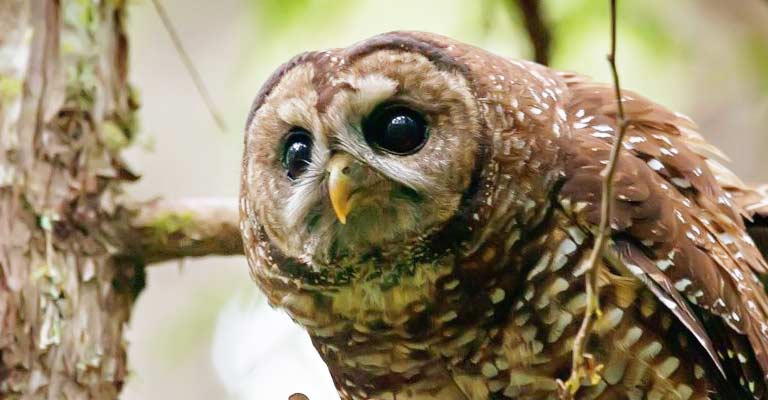
The facial disk of the Spotted Owl is round and well-defined, with a dark border.
Their large, dark eyes are set in a facial disk that helps funnel sound to their ears, aiding in their excellent hearing for hunting in low-light conditions.
Voice
Vocalizations are an important clue for identifying Spotted Owls. They have a distinctive hooting call that can be described as a series of four hoots, often transcribed as “Hoo-hoo-hoo, hoo-hoo.”
Recognizing their vocalizations, especially during the breeding season, can be crucial for confirming their presence.
Habitat
Spotted Owls are closely associated with old-growth and mature coniferous forests in mountainous regions.
They prefer dense, unfragmented forests with a mix of tree species, providing suitable roosting and nesting sites. Understanding their habitat preferences is key to locating them.
Geographic Range
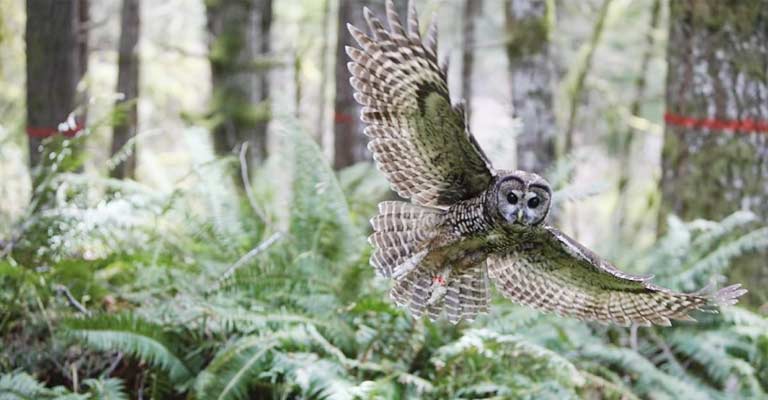
There are three recognized subspecies of Spotted Owl: the Northern Spotted Owl, California Spotted Owl, and Mexican Spotted Owl.
Understanding the geographic range of these subspecies is important for narrowing down the possibilities when identifying a Spotted Owl.
Behavior
Spotted Owls are primarily nocturnal, with their activity peaking during the night. They are skilled hunters, preying on small mammals like mice and flying squirrels.
Observing their behavior, especially during the night, can provide additional clues for identification.
Conservation Status
Due to habitat loss and other threats, Spotted Owls are considered a threatened species in many parts of their range.
Knowing the conservation status and being aware of efforts to protect their habitat can add to the context of identifying these owls and understanding the importance of their conservation.
Identifying the Spotted Owl involves a combination of visual and auditory cues, knowledge of their habitat, and an understanding of their behavior.
Patience and careful observation in suitable habitats during their active periods are key to successfully recognizing this iconic owl species.
Taxonomical details of Spotted Owl
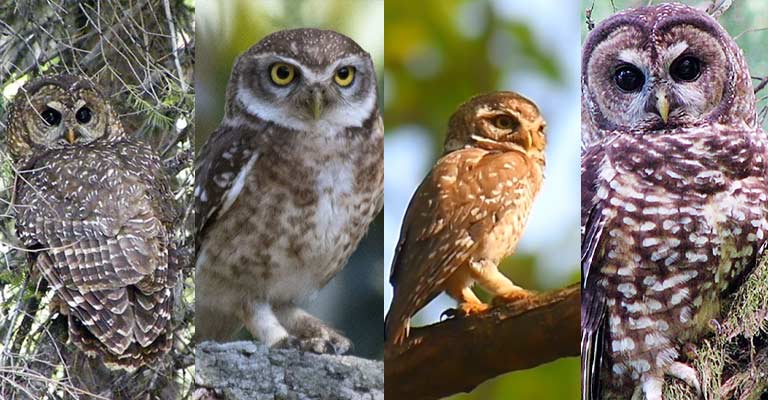
Here’s a table summarizing the taxonomy details of the Spotted Owl:
| Taxonomic Rank | Classification |
| Domain | Eukaryota |
| Kingdom | Animalia |
| Phylum | Chordata |
| Class | Aves |
| Order | Strigiformes |
| Family | Strigidae |
| Genus | Strix |
| Species | S. occidentalis |
The Spotted Owl (Strix occidentalis) encompasses three distinct subspecies, each adapted to specific regions across North America.
Understanding the characteristics of these subspecies sheds light on the diversity within the Spotted Owl species.
- Northern Spotted Owl (S. o. caurina): Found in the dense coniferous forests of the Pacific Northwest, the Northern Spotted Owl is a symbol of old-growth habitat conservation. Its plumage is characterized by a mottled pattern of white spots, providing effective camouflage in the lush, dark forests. Due to habitat loss and fragmentation, this subspecies faces significant conservation challenges, making it a focal point for wildlife protection efforts.
- Mexican Spotted Owl (S. o. lucida): Inhabiting the mountainous regions of Mexico and parts of the southwestern United States, the Mexican Spotted Owl prefers canyons and rugged landscapes. Distinguished by its unique vocalizations and habitat preferences, this subspecies faces threats from habitat destruction and climate change. Conservation initiatives strive to preserve the intricate ecosystems crucial for its survival.
- California Spotted Owl (S. o. occidentalis): Thriving in the coniferous forests of California and the western United States, the California Spotted Owl is an integral part of the region’s biodiversity. It shares similarities with the Northern Spotted Owl but displays subtle differences in plumage.
Conservation efforts focus on maintaining the health of the Sierra Nevada and other suitable habitats to ensure the long-term viability of this subspecies.
Together, these Spotted Owl subspecies exemplify the adaptability of the species to diverse environments while highlighting the urgent need for conservation measures to safeguard their habitats and ensure their continued presence in North American ecosystems.
Spotted Owl Life History
The Spotted Owl (Strix occidentalis) is a species of owl native to North America, recognized for its elusive nature and association with old-growth forests.
Understanding the life history of the Spotted Owl involves delving into various aspects, including its food habits, breeding behavior, potential diseases, treatments, and ongoing conservation efforts.
Food
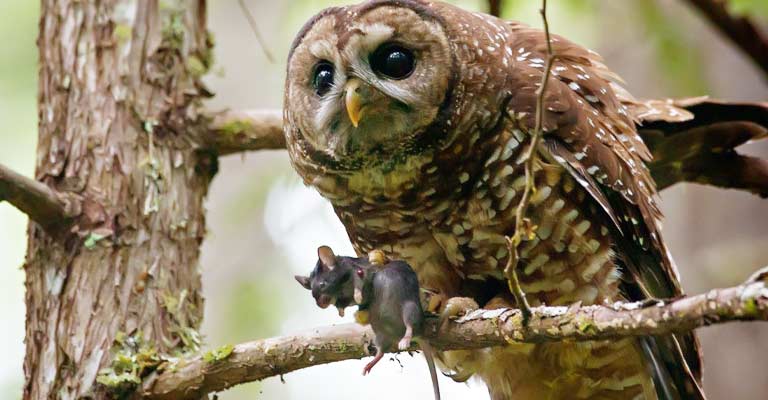
Spotted Owls are primarily carnivorous and have a diverse diet that mainly consists of small mammals. Their prey includes flying squirrels, woodrats, mice, and other small mammals found in their forested habitats.
These owls are nocturnal hunters, using their keen sense of hearing to locate prey in the dark. The effectiveness of their silent flight allows them to ambush their prey with precision.
Habitat
Spotted Owls are strongly associated with mature and old-growth coniferous forests, particularly those dominated by species like Douglas fir, western hemlock, and redwood.
These forests provide the owls with suitable roosting and nesting sites, as well as an abundant supply of prey.
They are particularly sensitive to habitat fragmentation, making the conservation of large, contiguous forest areas crucial for their survival.
Range Map
The Spotted Owl has a diverse range that spans from the dense forests of the Pacific Northwest to the mountainous regions of Mexico.
Three subspecies are recognized: the Northern Spotted Owl, the California Spotted Owl, and the Mexican Spotted Owl.
Range maps illustrate their distribution, emphasizing the importance of protecting suitable habitats across their entire range to maintain healthy populations.
Breeding
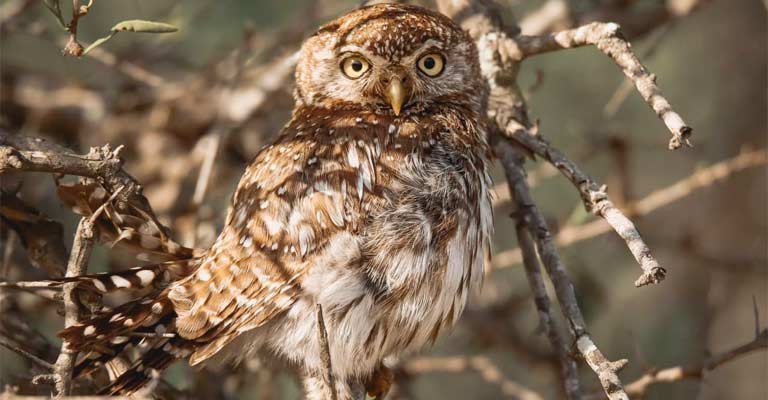
Spotted Owls typically form monogamous pairs and engage in elaborate courtship rituals during the breeding season, which usually occurs in late winter or early spring.
Nests are often located in tree cavities, and these birds are known for their fidelity to specific territories.
The female lays a small clutch of eggs, and both parents share incubation duties. The chicks hatch, and the parents work together to provide food until the young owls fledge and become independent.
Diseases
While Spotted Owls face numerous threats due to habitat loss, they are also susceptible to diseases such as West Nile virus and avian pox. These diseases can impact their overall health and reproductive success.
Monitoring and understanding disease dynamics in Spotted Owl populations are essential for effective conservation strategies.
Treatment
Efforts to treat diseases in Spotted Owls often involve a combination of monitoring, research, and habitat management.
Surveillance programs help identify disease outbreaks, while habitat conservation aims to maintain the overall health of the owl populations.
Research into disease-resistant behaviors and genetic factors may also contribute to long-term treatment strategies.
Conservation
Conserving the Spotted Owl involves addressing the primary threat—habitat loss. Logging and urban development have significantly impacted their preferred old-growth forest habitats.
Conservation efforts focus on creating protected areas, implementing sustainable forestry practices, and managing landscapes to maintain suitable habitats.
Additionally, captive breeding and reintroduction programs aim to bolster declining populations.
The life history of the Spotted Owl is intricately linked to its habitat, food sources, and breeding behavior.
Conservation efforts must encompass a holistic approach that addresses not only the immediate threats but also the long-term sustainability of the ecosystems in which these majestic owls thrive.
Nesting Habit of Spotted Owl
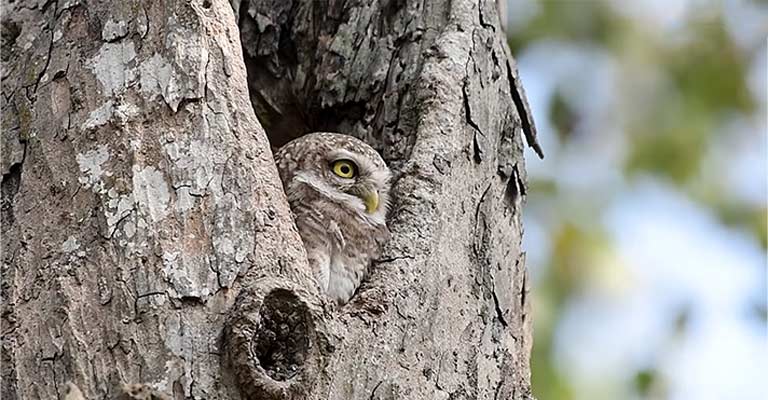
| Nesting Details of the Spotted Owl (Strix occidentalis) |
| Aspect | Details |
| Clutch Size | Typically 2 eggs, occasionally 1 or 3 |
| Number of Broods | Usually 1 per breeding season |
| Egg Length | Approximately 2 inches (5 cm) |
| Egg Width | Around 1.7 inches (4.3 cm) |
| Incubation Period | Approximately 28 to 32 days |
| Nestling Period | Approximately 34 to 36 days |
| Egg Description | White and slightly glossy with a slightly grainy texture |
| Nest Type | Often located in tree cavities, sometimes on platforms |
| Nest Height | Varies, usually high in trees |
| Parental Involvement | Both males and females share incubation and feeding |
| Nesting Habitat | Old-growth and mature coniferous forests |
| Nesting Territory | Typically within the established breeding territory |
Understanding the nesting details of the Spotted Owl provides valuable insights into their reproductive behavior and the factors contributing to successful breeding.
The species’ preference for specific nest sites and the cooperative efforts of both parents in incubation and feeding highlight the intricacies of their nesting behavior.
Conservation efforts often consider the protection and preservation of suitable nesting habitats as crucial elements in ensuring the continued success of Spotted Owl populations.
Behavioral Habits of Spotted Owl
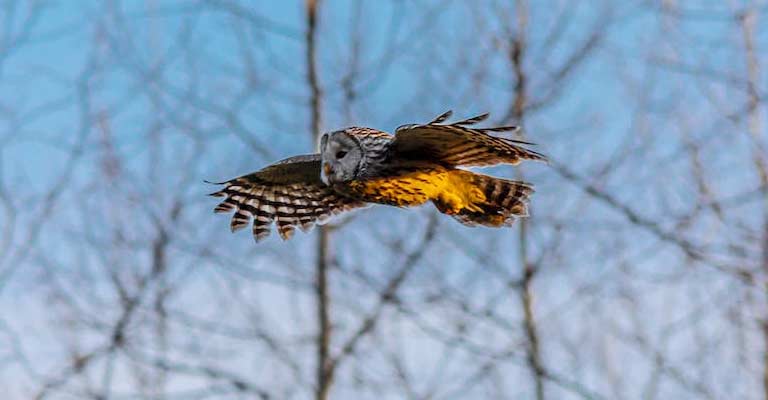
The Spotted Owl (Strix occidentalis) is a fascinating nocturnal bird species indigenous to North America.
Renowned for its elusive nature and preference for old-growth forests, the behavioral habits of the Spotted Owl are essential to understanding its survival strategies and ecological role.
Nocturnal Lifestyle
The Spotted Owl is primarily nocturnal, exhibiting heightened activity during the night.
This behavioral adaptation allows them to capitalize on the darkness for hunting, utilizing their exceptional low-light vision and acute hearing to locate prey such as small mammals.
Territoriality
Spotted Owls are territorial birds, fiercely defending their chosen territories, especially during the breeding season. The territories typically encompass suitable nesting sites and abundant hunting grounds.
These territories help reduce competition for resources and provide a stable environment for raising their young.
Courtship and Pair Bonding
During the breeding season, Spotted Owls engage in elaborate courtship rituals. This includes hooting calls, mutual preening, and aerial displays.
Once a pair forms a bond, they often remain monogamous and display strong fidelity to their chosen breeding territories.
Nesting Behavior
Nesting habits involve selecting suitable tree cavities for shelter, often located in old-growth forests. Both male and female Spotted Owls contribute to incubating the eggs and caring for the chicks.
The choice of nesting sites and the cooperative efforts of both parents underscore the significance of undisturbed habitats for successful reproduction.
Silent Flight
Adaptations in the wing and feather structure of Spotted Owls enable silent flight, minimizing noise during hunting and allowing them to approach prey stealthily.
This silent flight is a remarkable behavioral adaptation that aids in ambushing prey without detection.
Social Structure
Spotted Owls exhibit solitary behaviors outside the breeding season, with minimal interactions between individuals.
However, during the breeding season, pairs engage in vocalizations and territorial displays, emphasizing the temporary shift in social dynamics.
Anti-Predator Behavior
When faced with potential threats, Spotted Owls may display anti-predator behaviors such as vocalizations, bill snapping, and aggressive postures.
These behaviors serve to deter potential threats and protect their nesting territories.
Understanding the behavioral habits of the Spotted Owl is crucial for implementing effective conservation strategies.
Preserving their preferred old-growth habitats, maintaining large, contiguous territories, and minimizing disturbances during the critical breeding season are essential components of ensuring the continued well-being of this iconic owl species.
Wrapping Up
The Spotted Owl, with its nocturnal habits, territorial nature, and intricate nesting behaviors, epitomizes the delicate balance between adaptation and ecological dependency.
Understanding these aspects is paramount for effective conservation, emphasizing the need to protect their old-growth habitats and mitigate the impact of habitat fragmentation.
The Spotted Owl’s behavioral nuances not only contribute to its ecological significance but also serve as a poignant reminder of the interconnectedness between wildlife and their habitats. Thank you so much.